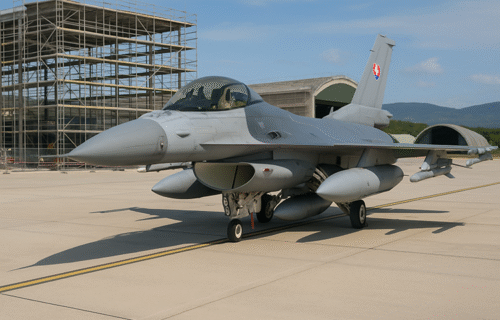Slovakia’s transition to a fleet of American-made F-16 fighter jets marks a decisive step in its post-Soviet defence evolution — one that underscores both the country’s NATO commitments and its response to the rapidly changing security environment in Eastern Europe. The €1.6 billion programme, approved in 2018, will replace the retired MiG-29 aircraft and anchor Slovakia firmly within NATO’s Integrated Air and Missile Defence System (NATINAMDS).
According to the Slovak Ministry of Defence, all 14 F-16 Block 70/72 aircraft are expected to be operational by 2027, coinciding with the completion of a major reconstruction of the Sliač Air Base. Until then, the aircraft will operate from Malacky-Kuchyňa. The Sliač upgrade — Slovakia’s largest military infrastructure investment since joining NATO — is co-funded through allied programmes and designed to accommodate the security, communications, and maintenance requirements of modern NATO-standard aircraft.
President Peter Pellegrini, visiting the base in October, described the reconstruction as “an investment not only in the military, but in the future of Slovakia’s regional infrastructure.” He noted that the works were planned to allow the return of civilian operations at a later stage. The modernisation includes new taxiways, hardened hangars and rapid-response shelters for emergency readiness.
The shift to F-16s also represents a clear geopolitical realignment. After Russia’s full-scale invasion of Ukraine in 2022, Slovakia accelerated its withdrawal from reliance on Russian military systems. In 2023, Bratislava transferred its remaining MiG-29s to Ukraine, closing a decades-long chapter of technical dependence on Moscow. NATO officials have since highlighted Slovakia’s fleet upgrade as critical for strengthening the alliance’s eastern air-defence corridor.
Within NATO’s framework, Slovakia’s F-16s will participate in joint air-policing missions across Central and Eastern Europe — including Baltic and Black Sea rotations — alongside allied fleets from Poland, Romania and Hungary. Defence analysts say the aircraft’s advanced radar and surveillance systems will extend NATO’s early-warning reach over the Carpathian region, reinforcing deterrence against potential airspace violations.
Despite the programme’s strategic value, it has not been without scrutiny at home. Opposition parties have questioned rising costs and the delayed delivery schedule, which has slipped roughly two years beyond initial projections. The Ministry of Defence has attributed the delays to global supply-chain pressures and the expanded reconstruction scope at Sliač. A 2025 NATO defence readiness review, however, commended Slovakia for maintaining progress on its capability targets despite fiscal constraints.
Beyond defence implications, the F-16 deal also deepens Slovakia’s industrial ties with the United States. Several local firms are involved in maintenance, logistics and parts supply, creating what the Ministry describes as “a new long-term ecosystem for defence technology cooperation.”
When fully deployed by 2027, the F-16 fleet will not only replace outdated aircraft but also symbolise Slovakia’s full integration into NATO’s collective defence architecture. In a region where geopolitical boundaries and threats are constantly shifting, the project stands as both a strategic safeguard and a statement of Slovakia’s Western alignment.
